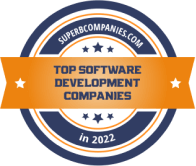Bootstrapping vs. Seeking Venture Capital: What’s Right for Your Startup?
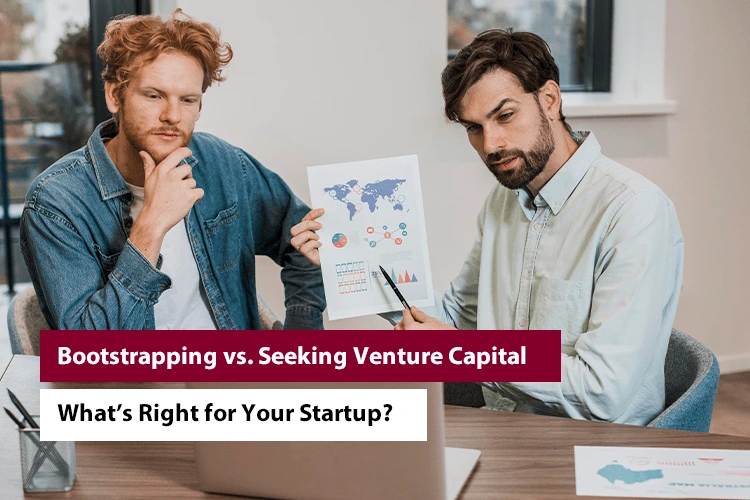
Jeff Bezos, the former CEO of Amazon started the company in his garage with a handful of employees after selling his first book in 1995. Today, the company has grown to be the world’s largest eCommerce store. Mark Zuckerberg launched Facebook from his dorm room while he was in college. Today, Facebook is the world’s largest social media platform.
These companies are major examples of bootstrapping. Bootstrappers take an idea and, using talent and professionalism, create a solid business without the backing of investors and with little or no starting capital.
Airbnb is a global platform for lodging and travel experiences. To give it a headstart, co-founders Brian Chesky, Nathan Blecharczyk, and Joe Gebbia obtained early-stage funding from prominent VC firms. The company soon experienced strategic growth. Today, it is a household name and a testament to the impact of venture capital in driving success.
Bootstrapping vs. Venture Capital: A Comparative Guide for Entrepreneurs
When it comes to financing a startup, entrepreneurs have to decide between bootstrapping vs. venture capital. Bootstrapping involves using personal savings and revenue to carry out business activities. Venture capital entails obtaining external investments in exchange for equity.
Let’s look more closely at these two options, weighing their pros and cons. By the end of the post, you’ll be able to make an informed decision about what to choose.
What Is Bootstrapping?
The word “bootstrapping” comes from the classic phrase “to pull oneself up by one’s own bootstraps.” Bootstrapping is a situation where the startup founder begins a company with little capital.
They majorly depend on their personal savings, sweat equity, quick inventory turnover, lean operations, and a cash runway. For example, a bootstrapped business may take preorders for its product. It can thus use the funds generated from the orders to build and deliver the product itself.
Is Bootstrapping a Good or Bad Strategy?
The Microsofts and the Apples of the world stand as proof that bootstrapping is the path to success. That’s why, more startups than ever today are taking this route. But what works for one may not work for another. To determine whether bootstrapping is good or bad for your business, a clear understanding of its pros and cons is necessary.
Pros of Bootstrapping
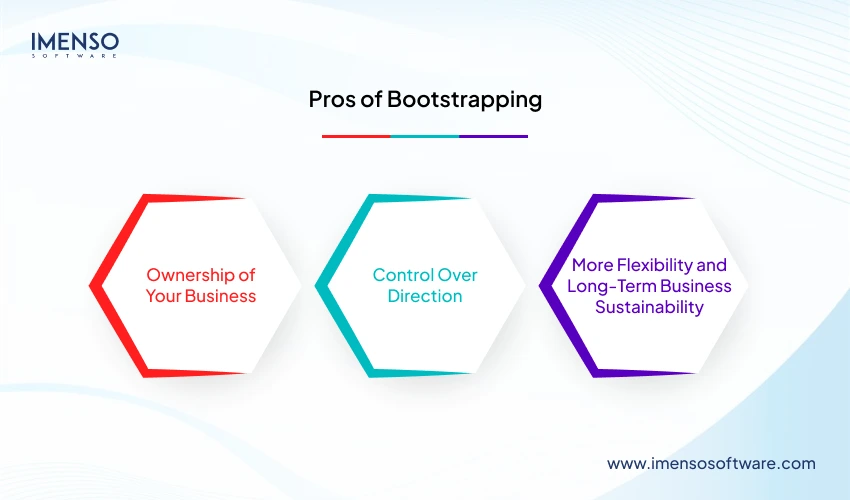
Ownership of Your Business
Among all the bootstrapping benefits, one of the main ones is the ownership it gives you over your business. A solo entrepreneur retains full control over the business. It means that the ultimate decision-making power rests on you. Even with a co-founder or two, your share of the equity will be much greater than if you go through various rounds of fundraising. It continuously dilutes your ownership. Bootstrapping even a small company with less revenue is beneficial because your share may be worth more than if you raised money to obtain a billion-dollar valuation.
Control Over Direction
Whenever you borrow money from an external source, you directly or indirectly become responsible for satisfying other’s interests. Although you began the company with your own idea, you face the dilemma of modifying your vision to suit what other people want. While there are solutions like super-voting rights, if you want to retain artistic control and direction, bootstrapping is the ideal option.
More Flexibility and Long-Term Business Sustainability
Bootstrap makes startups agile and adaptable to market changes. Since they do not rely on external investors, entrepreneurs can pivot their business model, and bring new features or improvements without going through a lengthy approval process. Moreover, without external startup funding options, entrepreneurs are forced to generate revenue quickly to keep their businesses afloat. This makes them work with a customer-centric mindset focused on delivering valuable solutions.
Bootstrapped startups have limited financial resources. So, they are judicious with their spending, using it only where it brings value. This mindset fosters long-term sustainability and helps them navigate challenging economic conditions.
Cons of Bootstrapping
You Bear Any (or All) Financial Risk
The most pronounced con of bootstrapping is that you are putting your own hard-earned money into something that may or may not give you the expected results. If your business experiences a lack of sales or an unexpected expense, you’ll be directly impacted. Bootstrapped businesses are at a greater risk of stagnant cash flow.
Less Credibility
Bootstrapping prevents you from building the connections you need for business growth because you don’t have backing from reputed investors. You need to work hard to attract your customers and find opportunities to collaborate on your own. This process is much more challenging because you don’t have the guidance and funding from someone who knows the startup arena.
Slower Growth
Bootstrapped companies are often faced with a resource crunch. Their budget does not permit them to spend money on paid marketing initiatives such as Google ads or social media advertising. Thus, they face a tough time generating the audience’s interest and achieving exponential growth.
Examples of Startups That Succeeded With Bootstrapping
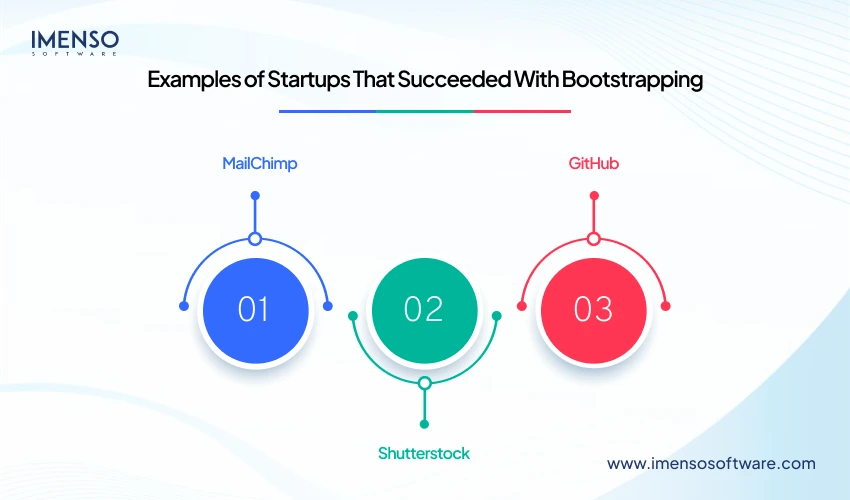
Hundreds of bootstrapped startups have gone on to be wildly successful. They’ve earned billion-dollar valuations after beginning with almost nothing. Here are 3 such startups.
MailChimp
In 2000, Ben Chestnut and Dan Kurzius were the owners of a design consulting business. Their clients asked for an e-newsletter, which at that time, was a tedious process. So, their team worked to create a better way to design email newsletters. This led to the birth of MailChimp.
Now, after 20 years, the co-founders’ bootstrapped business is worth more than $10 billion! They worked within the restraints of their existing design firm, treating MailChimp as an extension that gradually grew past what they ever imagined it to!
Shutterstock
Shutterstock’s founder Jon Oringer was a professional software developer. However, he was also an amateur photographer. Oringer combined his two professional experiences to establish a stock photo website, Shutterstock from his own library of over 30,000 photographs. In 2012 Shutterstock had its IPO. A decade later, its valuation is $4.42 billion!
GitHub
GitHub, a web-based hosting service for software development projects was founded by Tom Preston-Werner, PJ Hyett, Chris Wanstrath, and Scott Chacon. They began it as a weekend project. The cost of bringing GitHub into full-time operation was borne by the founders themselves.
Soon, the platform took off. As it grew in popularity, the founders left their day jobs to focus on the business by working multiple hours from various locations. They released products and improved them with customer feedback. Today, GitHub is used by more than 100 million developers worldwide.
Also Read:
How to Use Market Research to Validate Your Business Idea
Multifeatured Cloud Computing Solutions For Growth-Seeking Startups
The Role of IT Services in Building Resilient Startup Ecosystems
What Is Venture Capital?
Venture Capital (VC) provides funding to small businesses and startups that have good potential to grow. This financing occurs through private equity (PE). In exchange for their investment, VC firms get ownership stakes in the businesses they support. Venture capital is commonly introduced at different phases of a company’s development.
VC funding focuses on budding startups. Private equity finances established businesses wanting an equity infusion. Venture capital is an important financial resource for startups who do not have access to bank loans or capital markets.
Is Venture Capital Good for Startups?
Like bootstrapping, venture capital has been increasingly being used by startups and small businesses. But you can only decide if it is right for you or not after weighing venture capital’s pros and cons.
Pros of Venture Capital
Substantial Funding
The most obvious pro of venture capital is the money provided by VC firms. These firms pool resources from multiple resources to give your startup a large sum of capital which can be as high as $25 million. It’s not easy to get this much amount through small business loans, which usually reach up to $5 million.
The funding provided by venture capitalists helps startups grow and expand faster. In today’s fast-moving marketplaces, quick growth enables small businesses to outpace competitors and achieve a defendable market share.
Hands-on Support
VC funding comes with hands-on support. This is because the venture capitalists investing in your business want a return on their investment. Thus, they are happy to give you as much support as needed. A few investors do not get involved as much. However, VC funding gives startups access to resources, guidance, logistics, a huge network, and HR. This facilitates a strong foundation for the company.
No Repayments
There are no monthly repayments with VC investments, unlike small business loans. Instead, VC firms ask for a share in your business. So, when your company grows its net worth increases, the venture capitalist investors can sell shares for more than they originally paid. This takes away the stress of paying back and lets businesses concentrate on growth initiatives.
Cons of Venture Capital
Loss of Control
When seeking venture capital, startup founders usually have to give up equity in their company. It means sharing decision-making authority with the venture capitalists. They have to consult them and proceed with strategic decisions only after they are fine with that. Founders do not retain full autonomy. Moreover, VCs tend to have high expectations for the startups they invest in. They want a good return on their investment in a short span. This puts undue stress on the business to achieve rapid growth.
Dilution of Ownership
Accepting venture capital funding dilutes the ownership stake of the startup founder and remaining shareholders. This can result in a reduced share of profits. Not only that, but the founder also does not have full control over the direction in which they want to take their business.
Limited Exit Options
Venture capitalists usually have a specific timeframe in mind for their investments. They exit the investment and realize their returns within a set period, often through an initial public offering (IPO) or acquisition. This limited exit horizon can put pressure on startup founder to meet specific milestones even though it may not align with their original and long-term vision.
Examples of Startups That Succeeded With Venture Capital
Many startups globally have used venture capital funding and achieved enormous success. These companies have today become household names in their respective industries.
Uber
Founded in 2009 by Travis Kalanick and Garrett Camp, Uber revolutionized the traditional taxi industry with its innovative approach to transportation. It secured early funding from a mix of angel investors, VC firms, and strategic partnerships. By leveraging their extensive networks and pitching their unique concept, the founders secured initial funding of $1.5 million.
As Uber gained traction, the funding rounds became more substantial. In 2011, Uber raised $11 million in Benchmark Capital’s Series A round. This huge amount led it to expand across cities. By 2013, Uber closed a $258 million Series C round by Google Ventures, increasing its valuation to above $3.5 billion.
Airbnb
Brian Chesky, Joe Gebbia, and Nathan Blecharczyk founded Airbnb Founded in 2008. In the first few years, the founders struggled to secure funding. But they persisted and eventually secured a $20,000 investment from Paul Graham of Y Combinator, a famous startup accelerator. This allowed the founders to develop Airbnb.
Soon, the platform grew in popularity, and in 2011, it secured $112 million in Andreessen Horowitz’s Series B round. The money led the founders to expand their operations internationally and invest in new technology and marketing. After securing $1 billion in 2015, Airbnb’s valuation climbed above $30 billion.
Warby Parker
Warby Parker, a direct-to-consumer eyewear company began in 2010. It offered affordable, stylish eyewear while also creating a positive social impact. In its initial days, the company raised $2,500 via a crowdfunding campaign. Through this funding, the founders created their first collection of frames.
The unique business model and mission of the company led it to secure a $12 million Series A round in 2011. This enabled the business to expand its product line and scale its operations. Warby Parker continued to secure more funding, including $100 million in 2015 which led it to support its growth.
Should Your Startup Bootstrap or Raise Venture Capital?
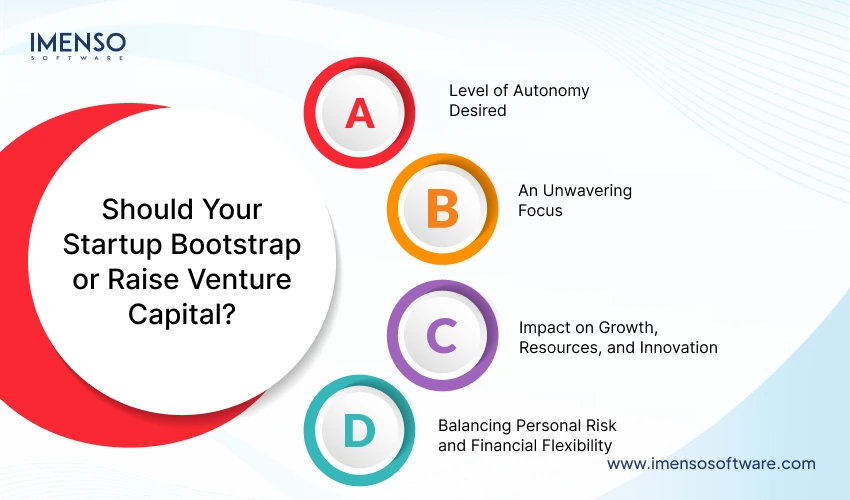
Choosing the right funding path for startups is crucial to gaining traction, growth, and scale. Bootstrapping and venture capital are two different approaches. A sound decision after taking into account the following considerations.
Level of Autonomy Desired
Autonomy is a primary starting point for deciding between bootstrapping vs. VC funding. Bootstrapping gives you full independence regarding the kind of products you want to develop, markets to enter, and the workforce to hire. In other words, you are the sole decision-maker.
Contrarily, VC investment won’t give you as much control over all aspects of your business. Your investors will want a portion of control in your business because they are funding it. If you desire complete control, bootstrapping is the way to go. If not, consider venture capital funding.
An Unwavering Focus
With VC funding, you need to focus on other things that are indirectly related to your startup’s growth. For example, you’ll need to have regular meetings with your investors and maintain good relationships with them. This helps your business by allowing you to network with more people and adding credibility to your business. However, any wrong step on your part or any kind of misunderstanding between you and your VC can put an end to this partnership and subsequent funding. So, you have to tread the path cautiously.
One of the major bootstrapping benefits is that it gives you the freedom to focus on wherever you want to improve or expand. You can put your customers first, spend the earnings however you want, or change any area you don’t resonate with. It has been seen that with VC funding, businesses find it challenging to be more customer-centric because they are torn between fulfilling the responsibilities that come with this venture investment.
Impact on Growth, Resources, and Innovation
Another important thing to consider when comparing bootstrapping vs. VC funding is the amount of money you have to fund your growth. With bootstrapping, you have little money to reinvest into your business. So, you’ll have to inevitably compromise on the profit. For a very long time, it’s not feasible to experiment with new products or scale your business because you don’t have the support to back these initiatives.
Venture capital investment offers startups with expert resources, connections, and instant networks. While you have to operate within the terms and conditions of the investor, it enables you to get the right attention at the right time.
Balancing Personal Risk and Financial Flexibility
Neither of the two Startup funding options we’ve discussed can guarantee success. As already seen above, many entrepreneurs have thrived with bootstrapping. Similarly, many have achieved enormous success with VC funding. However, bootstrapping comes with a greater personal risk. When you bootstrap, you are using your personal savings or funds to stay afloat. If something bad happens, you lose all your money. So, you need to be prepared for that scenario.
With venture capital, this personal risk is not there. You can experiment more without the fear of losing money as long as you have good relationships with your investors. However, the type of agreement and investment will dictate how the failure of your business will impact your bottom line.
There is no single one-size-fits-all approach to funding. Numerous startups have stood tall on their boots with bootstrapping while others have risen to great heights through VC funding. Ultimately, the choice boils down to your personal expectations and the kind of business model you have in mind. The decision to choose between bootstrapping vs. VC funding is not right or wrong. Rather, it is deeply personal and aligns with the founder’s vision for their business.
Growing Ideas into Million-Dollar Businesses: How Imenso Software Can Help
Startups, irrespective of their funding options have to navigate uncharted waters with limited budgets, higher risk, and a smaller team. What everyone has in common is a passion to realize their vision and achieve success. Entrepreneurs don’t just create a digital product, but something that can improve lives.
It’s exactly here that the magic of custom software development lies. It’s the ability to transform innovative ideas into impactful products. At Imenso Software, we specialize in creating blazing-fast products for startups that best resonate with their target audience. We incorporate the latest technologies into your software’s functionality and design, helping you stay ahead of the curve. Imenso Software isn’t just a development company. We are a long-term growth partner for your startup. Kickstart your digital journey by contacting us today or read what our clients have to say about our work.
We’re honored to mention that our efforts have been recognized by renowned B2B review and research platforms such as GoodFirms, Clutch, MirrorView, and many more.
Want more information about our services?
Similar Posts

7 Must-Have IT Solutions to Boost Workflow Efficiency in Startups
Are you finding it difficult to run your startup efficiently? Many start-ups do, and they encounter refusal during expansion. Managing several tasks, allocating time and resources, and keeping the team aligned can be tough. Without appropriate tools, workflow and some bottlenecks make the fastest growth more difficult. But what if there was a way to […]...

Product Roadmap for Startups: Aligning With Your Business Strategy
“Whenever you see a successful business, someone once made a courageous decision.” Peter Drucker Of course, the courageous decision can be starting a business. But it can also be creating a product roadmap. An effective roadmap presents a clear path forward, communicating how an organization’s short-term efforts align with its longer-term objectives. When done right, […]...

IT Roadmap for Startups: From Launch to Scalability
Do you ever ask yourself how some start-ups move up the ladder with ease while others struggle to do so? The secret is sometimes having a strategic IT plan in place. This pace can be daunting to startups, especially because it’s in the technology industry, but it is also an opportunity to improve the odds. […]...









